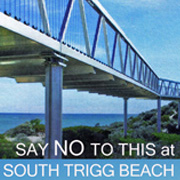
Preliminary Analysis of Broader Life Cycle
Environmental Social and Economic Costs and Benefits
Prepared by Prof Paul E Hardisty
As requested, please find below a brief preliminary analysis of broader costs and benefits of the boardwalk options. I have taken a total cost option, to use as a notional comparison point for what likely additional benefits would have to be to justify construction.
I have used unit values for ecosystem services (coastal habitat), using a survey of 23 Australian and 7 global studies available in the literature, converted to 2013 Australian dollars. Data on City of Stirling and the proposed boardwalk concepts from the City's website (number of households, area covered by native bushland, etc.).
UNIT VALUES:
Given that City of Stirling remnant bushland area is 500 ha, from an estimated total area of the city of 100 km2, remnant natural ecosystem coverage is approximately 0.5% (one half of one percent). On this basis, remnant ecosystem values are assumed at the high end of the range in the studies surveyed, at $23,000ha/yr.
Studies worldwide show high willingness to pay (WTP) (value) among users of beach and coastline. Users prefer "unspoiled" beach, to "spoiled" beach in study after study. Median WTP in Australia for coastal recreation is $182/hh/yr. (hh=household) There are 88,000 households in Stirling. The total area of dune ecosystem potentially affected indirectly is approximately 8.0 ha.
OPTION A:
>Capital cost $ 1.056 m.
>Direct ecosystem loss: 0.27 ha = $ 0.186 m over 30 years, undiscounted.
>Dune ecosystem fragmentation loss = near zero
> Coastal amenity loss = near zero.
Total cost A = $1.24 m
OPTION B:
>Capital cost $ 3.8 m.
>Direct ecosystem loss: 0.036 ha = $ 0.025 m over 30 years, undiscounted.
>Dune ecosystem fragmentation loss (assume 25%) = 2.0 ha. = $1.38 m over 30 years undiscounted
> Coastal amenity loss = near zero
Total cost B = $ 5.2 m
OPTION C:
>Capital cost $ 1.87 m.
>Direct ecosystem loss: 0.1984 ha = $ 0.137 m over 30 years, undiscounted.
>Dune ecosystem fragmentation loss (assume 10%) = 0.8 ha. = $0.55 m over 30 years undiscounted
> Coastal amenity loss (assume 10% of users choose to go to another beach because of dune degradation and loss in amenity) = $0.2 m for 30 years = $6.0 m undiscounted.
Total cost C = $8.55 m
CONCLUSIONS:
Each of the options must demonstrate that over the long term (30 years used here) it will generate more overall value than it will cost, overall. In this case, the overall lowest cost option (A) is approximately $4m less expensive than the next lowest cost option (B), and more than $7 m less expensive than the city's recommended option (C - hybrid), when all external non-market values are included in the analysis. Effectively, this means that in all cases, combined economic and safety benefits of path upgrading options must generate at least $1.24 m in additional value-added activity over 30 years. The study provided by the Tourism board in the City's submission simply states that it anticipates "significant" benefits. In this case, significant must mean at least $40,000 a year, for the next 30 years, in additional economic value to businesses (option A), and $ 285,000 a year for 30 years for Option C. Given the strip of coast involved, it is difficult to see where such value will come from. This should be demonstrated more explicitly, before proceeding with the project.
The City advocates Option C. While it represents the "middle ground" in terms of direct financial cost, it is by far the most expensive when all issues are considered and appropriately valued. This result suggests that Option C is the most damaging to environmental and social amenity overall, and that its benefits are unlikely to match its costs. Option C should be rejected.
Benefits not valued also include safety improvements over existing pathway (examination of historical accident records over this stretch would be useful here). Disamenity for homeowner’s views has also not been included, but would be expected to apply only to Option C, where an elevated clearly visible boardwalk would interrupt homeowner's views. This could add significantly to the overall cost of Option C.
LIMITATIONS
This is a preliminary study only, and is intended as a guide to how a more complete evaluation could be done. Nevertheless, the general trend of overall costs is considered robust, and all options were considered here using a standard set of unit value assumptions.
Prof Paul E Hardisty
Received 18 April 2013

* * * * *
Professional biography of Prof Hardisty - link.
Return to Main Page
For more information contact the Stop the Boardwalk Action Group at stoptheboardwalk@gmail.com